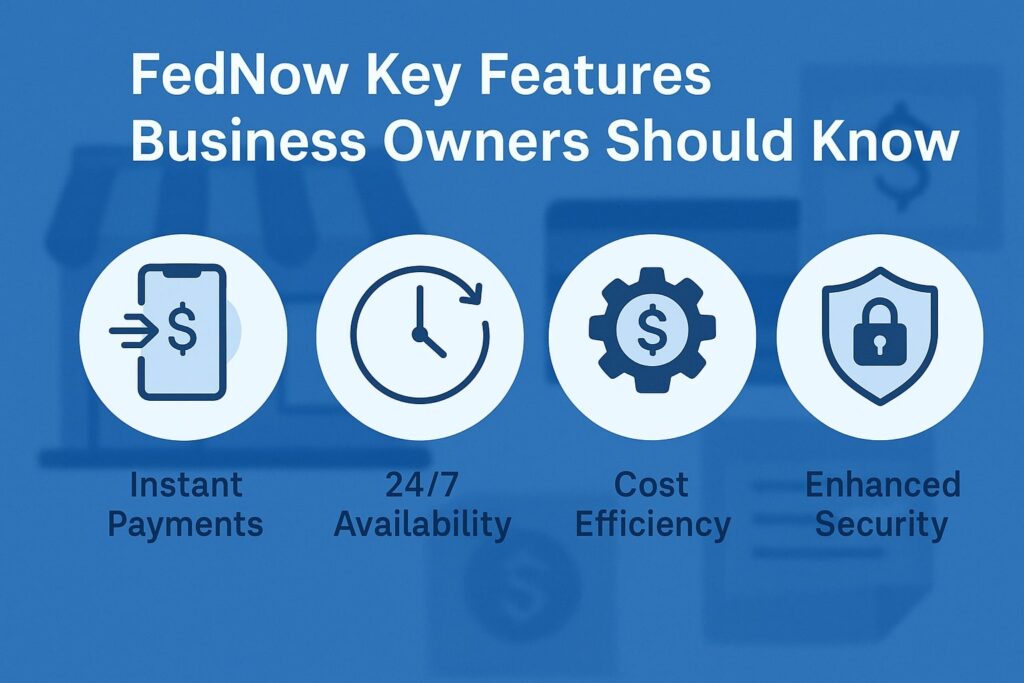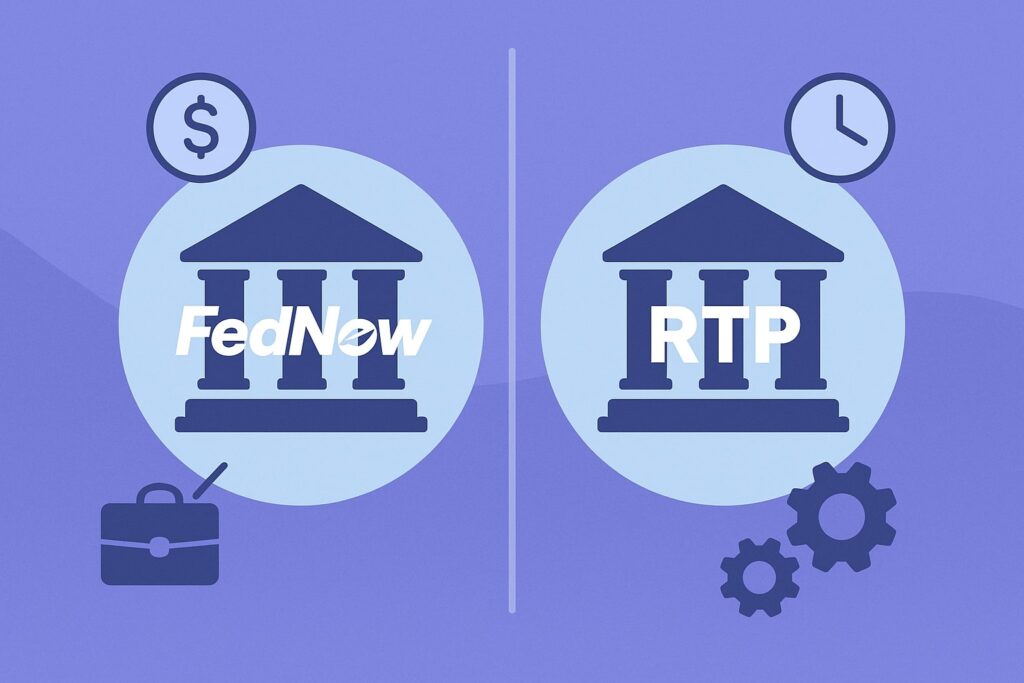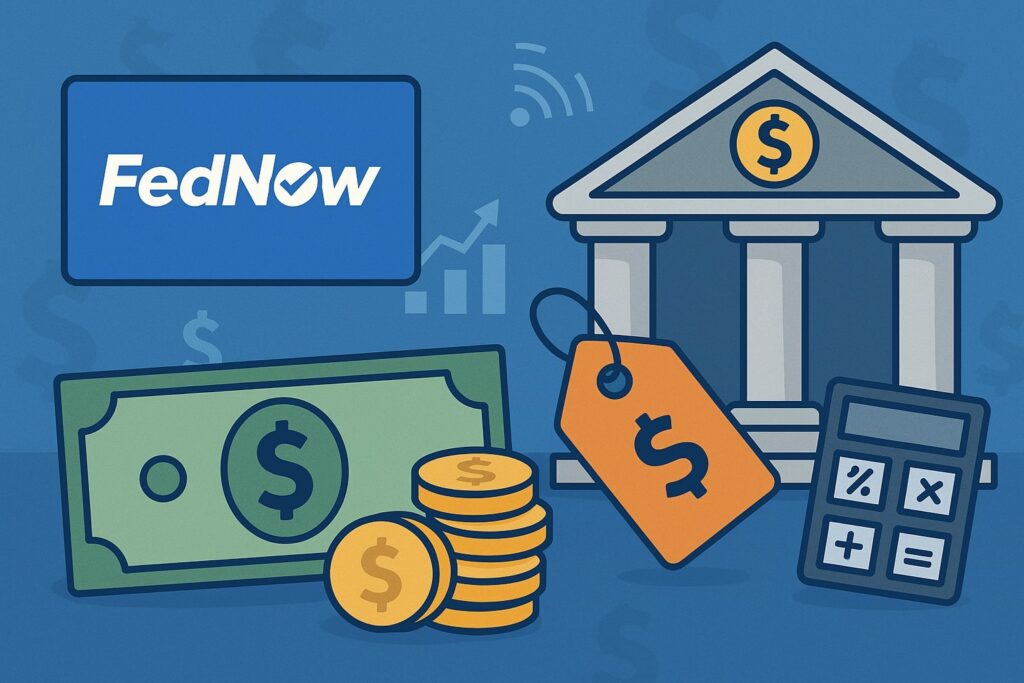
By p2pbusinesspayments October 26, 2025
FedNow is the Federal Reserve’s instant payment infrastructure that lets participating U.S. banks and credit unions move money in real time, 24x7x365. For business owners, FedNow means you can send or receive funds within seconds—no more waiting for nightly batches, weekends, or bank holidays.
Unlike consumer apps, FedNow operates at the bank-to-bank level, giving financial institutions the ability to offer instant payments directly inside business banking portals, treasury platforms, and accounting workflows.
Funds are final once settled, and recipients can use the money immediately, creating new cash-flow advantages for small and mid-sized businesses across the country.
FedNow: How It Works and Why It Exists
FedNow is a real-time gross settlement (RTGS) service with integrated clearing. When your customer pays you using a FedNow-enabled service from their bank, your bank receives and posts the funds instantly.
The Federal Reserve sits in the middle and settles the obligations between the sending and receiving institutions in real time, around the clock. That design removes the legacy “batch window” delays common in ACH, reduces counterparty timing risk, and ensures immediate funds availability for the receiver.
The Federal Reserve launched FedNow in July 2023 to modernize the U.S. payment system, complementing existing rails like Fedwire® (high-value, not 24/7) and ACH (batched, not instant).
FedNow does not replace the U.S. dollar, is not a cryptocurrency or CBDC, and runs alongside private-sector options such as The Clearing House’s RTP® network. It gives every eligible depository institution—large or small—a public instant rail to offer instant payments to consumers, businesses, and government agencies.
Key Features Business Owners Should Know

For businesses, FedNow emphasizes instant settlement and immediate use of funds. It supports core “customer credit transfers” (push payments) so payers authorize sending money to payees.
FedNow also offers Request for Payment (RfP), which lets a business send a digital, invoice-like request that a customer can approve to pay instantly. In addition, FedNow includes built-in dispute and inquiry message flows that help banks investigate issues without breaking real-time timing.
Risk tools are part of the platform. The Federal Reserve activated “account activity thresholds” in 2025 so participating banks can set dollar and velocity parameters by customer segment, improving fraud and anomaly detection on instant payments.
FedNow also supports participant-specific negative lists and receive-only onboarding, so institutions can join conservatively, receive payments first, then turn on sending after tuning risk.
What’s New in 2025: Limits, Risk Controls, and Growth
2025 has been a pivotal year for FedNow. In June, the network’s transaction limit rose from $500,000 to $1 million to support higher-value business use cases like supplier payments, real-estate transactions, and payroll funding.
Then, in September, Federal Reserve Financial Services announced a further increase: the FedNow network transaction limit will move to $10 million effective November 2025, unlocking even more commercial payments. Participating institutions still retain configurable default limits (commonly $100,000) that they can raise or lower based on risk appetite.
Adoption and volume have accelerated. The Fed’s public quarterly stats show rapid growth through 2025, with rising counts and values of settled payments as more institutions go live and expand use cases.
For business owners, this means greater odds your partners’ banks can send or receive instant payments and that instant workflows—collections, disbursements, just-in-time supplier pay—are increasingly viable nationwide.
FedNow vs. RTP: What’s the Difference for Businesses?

FedNow and The Clearing House’s RTP are both U.S. instant payment rails. Functionally, both deliver final, 24x7x365, account-to-account credit transfers with immediate funds availability. The practical differences relate to operators (public vs. private), pricing schedules, risk and message features, and each network’s participating banks and service providers.
Interoperability is not native today—your bank chooses which rails it supports, and some support both to maximize reach. For a business, the best option is often “whichever rail your bank and your customer’s bank both support,” with multi-rail coverage rising over time.
Strategically, small and mid-size banks embraced FedNow to access instant capabilities without relying solely on a private network. Meanwhile, RTP’s earlier start means it has mature functionality and adoption in certain segments.
Many banks and fintechs are going dual-rail to improve coverage and redundancy. Ask your institution which rails it supports and whether it can intelligently route instant payments to reach your partners.
Pricing: What FedNow Costs (Directly and Indirectly)

The Fed publishes a public fee schedule. For 2025, itemized fees include $0.045 per originated customer credit transfer (pacs.008), $0.01 per Request for Payment (RfP), and $1.00 per Liquidity Management Transfer (LMT).
There’s also a $25 monthly participation fee, which the Fed discounted to $0 during 2025; promotional credits may apply to the first 2,500 monthly transactions. Your bank may pass through or bundle these costs in your treasury services pricing. Always confirm your bank’s business checking/treasury plan to understand your all-in costs.
Beyond network fees, factor in indirect costs: integration to your ERP/accounting system, potential API charges, and change-management time for staff training.
As instant volumes scale, many businesses see net savings from fewer late fees, reduced float, fewer exceptions, and better cash-flow control—especially when instant disbursements replace checks or next-day ACH in time-sensitive workflows. (Your bank or provider can model the ROI with your actual payment mix using the public Fed fee schedule as a baseline.)
Participation: Which Banks Offer FedNow?
FedNow is available only through participating U.S. depository institutions and their service providers (cores, processors, and fintech platforms). The Federal Reserve maintains a public participant list that continues to expand across all 50 states.
If your bank isn’t live, many fintech and processor partners can still give you access through sponsor banks that already support FedNow. Ask your banker if they are “receive-only” or “send-and-receive,” since that affects whether you can originate payments, accept them, or both.
Public reporting and industry coverage show rising adoption among community banks and credit unions, with momentum among regionals as use cases mature. That growth improves reach: the more institutions that join, the more counterparties you can pay instantly without switching rails.
If your trading partners use a different instant rail, remember that multi-rail routing is increasingly common at banks and processors, so you may still achieve real-time reach via your provider.
The Messages Under the Hood: ISO 20022 and Why It Matters
FedNow uses ISO 20022 messaging—an XML-based standard that captures rich, structured data in each payment. Core messages include pacs.008 (customer credit transfer), pacs.004 (payment return), pacs.009 (liquidity management transfer), and pain.013 for Request for Payment.
The richer fields improve reconciliation, automate straight-through processing (STP), and support better compliance and analytics across your treasury stack. Banks also exchange administrative messages for status/ops, and the platform aligns closely with Fedwire’s ISO work where possible.
For a business owner, ISO 20022 means invoices, purchase orders, and remittance data can travel with the payment instead of being bolted on after the fact. That reduces keystrokes, improves matching in ERP, and shortens days-sales-outstanding.
Over time, the value of FedNow is not only “speed,” but also “data quality,” which helps automate payables, receivables, and exception handling—critical for lean finance teams.
Risk, Fraud, and Finality: What You Need to Know
Instant payments are irrevocable once settled, so strong controls matter. FedNow’s operating rules and 2025 enhancements let banks define transaction limits, segment-level thresholds, and negative lists.
Banks can also start in receive-only mode while calibrating risk systems, and they have access to built-in inquiry and investigation workflows to resolve issues without reversing good funds. Your internal controls—such as dual approval, least-privilege entitlements, and vendor verification—remain essential.
Because settlement is 24x7x365, fraud teams need always-on monitoring and playbooks. Work with your bank to enable alerts, role-based limits, device controls, and payee whitelisting.
Use RfP to reduce misdirected funds: because the payer approves a structured request from you, there is less reliance on free-form account entry. Build processes for “payment confirmation” and “out-of-band callbacks” for high-value first-time payments to new vendors.
Operating Hours, Limits, and Liquidity
FedNow operates continuously—nights, weekends, and federal holidays—so instant transactions never queue for a “window.” Banks manage liquidity across their master accounts and, where applicable, joint accounts backing private instant services.
FedNow also supports liquidity management transfers (LMT) so institutions can reposition funds to support instant activity; these LMTs run on the service and help banks stay within intraday liquidity tolerances.
Limits operate at multiple layers. The network limit (moving to $10 million in November 2025) sets the ceiling; banks can set default and customer-level limits below that ceiling. The Fed historically maintained a $100,000 default at the routing-number level, with configurable increases.
For high-value B2B payments, confirm your bank’s current per-payment and daily thresholds so you’re not blocked during critical disbursements.
Use Cases: Where FedNow Shines for U.S. Businesses
- Receivables & Invoicing: Combine FedNow with Request for Payment to collect faster, reduce DSO, and minimize chargebacks associated with cards.
Customers can approve your RfP from their bank app and you receive funds—plus structured remittance—instantly. This is ideal for professional services, wholesalers, and trades that want “pay now, post now” experiences without card interchange. - Disbursements & Payouts: Pay contractors, refunds, insurance claims, or supplier “release upon receipt” in real time, even after banking “cut-off.” Immediate availability helps field teams, gig workers, and small suppliers manage cash flow.
With the higher 2025 limits, you can push larger B2B payments on-demand instead of pre-funding early. - Cash-Flow Optimization: Move from “pay early to ensure on-time” to “pay exactly when due” and keep cash longer. Instant confirmation reduces ambiguity and late fees, while ISO 20022 remittance supports auto-match to invoices.
As more counterparties come online, FedNow enables same-day order fulfillment and just-in-time inventory release based on cleared funds.
Implementation Paths: How to Start
- Ask Your Bank: Confirm whether your bank supports FedNow receive and send, whether it also supports RTP, and what your per-item and daily limits are.
Also confirm availability of RfP, file or API initiation, and integration to your treasury portal or ERP. The Federal Reserve publishes up-to-date resources and participant information you can use in discussions with your institution. - Work With Your Processor or Fintech: Many cores, gateways, and treasury fintechs (listed as “service providers” by the Fed) provide FedNow connectivity, routing, and value-added features like risk scoring and reconciliation.
This can speed deployment and reduce custom development, particularly if you want multi-rail support across FedNow and RTP. - Pilot with Guardrails: Start with receive-only or with low per-transaction caps while you fine-tune user entitlements, approvals, and exception handling. Use dual approval, vendor onboarding checklists, and callback verification.
Add RfP where possible to minimize free-form entry risk. Then raise limits and expand to disbursements once controls are proven.
Compliance and Operating Rules Business Owners Should Recognize
FedNow participation is governed by Operating Circular No. 8 and the FedNow Service Operating Procedures, which define roles, liabilities, and required behaviors for senders and receivers.
While your bank shoulders most obligations, businesses should understand that instant payments are final, that returns use specific ISO messages, and that banks have defined timeframes to respond to information requests on suspected fraud. Ask your banker for their FedNow commercial terms and any supplemental agreements.
For investigations, FedNow supports message flows such as pacs.004 returns and related administrative messages, which your bank handles on your behalf.
This structure allows formal issue resolution even though the underlying payment is final, and ensures there’s a standard process to request more information or attempt recovery when appropriate.
FedNow and Your Tech Stack: Integration Tips
Because FedNow is data-rich, you’ll get the most value when you integrate it with your invoicing, ERP, and reconciliation workflows. Look for bank channels or APIs that deliver ISO 20022 data to your systems, not just a PDF receipt.
Ask about webhook callbacks for posting and matching, and whether your bank supports RfP generation from within your accounting software. Over time, structured remittance will save hours per week in manual reconciliation.
If you’re omnichannel, pair FedNow receivables with ACH for recurring, non-urgent payments and with cards for acceptance at the physical point of sale where card benefits matter.
For time-sensitive payouts or collections, configure business rules to route via FedNow or RTP automatically based on counterparty reachability and limit thresholds—your bank or provider can enable this.
The Bottom Line on FedNow for U.S. Business Owners
FedNow gives businesses a new way to move money instantly with finality and rich data, available directly through participating banks and credit unions. 2025 brought higher limits, stronger risk controls, and fast-rising volume—all signaling that real-time payments are becoming a mainstream business tool in the U.S.
If faster cash flow, instant confirmation, and cleaner reconciliation would help your operations, FedNow should be on your roadmap alongside ACH, wires, and cards.
Frequently Asked Questions (FAQs)
Q.1: Is FedNow a consumer app like Venmo or a cryptocurrency?
Answer: No. FedNow is not an app, wallet, or cryptocurrency. It is the Federal Reserve’s instant payment infrastructure that banks and credit unions use to offer instant payments inside their own channels. There is no new currency; dollars move between bank accounts with final settlement by the Federal Reserve. You access FedNow through your financial institution or its partners.
Q.2: When did FedNow launch?
Answer: The Federal Reserve launched FedNow in July 2023 after multi-year development and pilot testing. Since then, the Fed has published quarterly statistics showing steady growth in both payment volume and value as more institutions and providers go live.
Q.3: How fast are FedNow payments?
Answer: FedNow payments are near-instant. Settlement and funds availability occur in seconds, any time of day, on any day of the year—including weekends and holidays. That speed is built into the service design as a 24x7x365 RTGS with integrated clearing.
Q.4: What are the current transaction limits?
Answer: In June 2025, the Fed increased the network limit from $500,000 to $1 million, and in September 2025 announced a further increase to $10 million effective November 2025. Banks can still set lower default and customer-level limits (commonly $100,000) based on risk. Always confirm your bank’s specific caps before high-value payments.
Q.5: How much does FedNow cost to use?
Answer: The Fed’s 2025 fee schedule lists $0.045 per originated customer credit transfer, $0.01 per RfP, and $1.00 per LMT, plus a monthly participation fee (discounted to $0 in 2025). Your bank may pass through, discount, or bundle these costs in your treasury plan. Ask for your bank’s FedNow pricing and any promos.
Q.6: Does my bank support FedNow?
Answer: The Federal Reserve maintains a public list of participating financial institutions and service providers. If your bank isn’t on it—or is live as receive-only—ask about timelines or about accessing FedNow via a sponsor bank through your processor or fintech.
Q.7: How is FedNow different from RTP?
Answer: Both are instant, 24/7 rails. FedNow is operated by the Federal Reserve; RTP is private (The Clearing House). Pricing, risk controls, and participant rosters differ, and the rails aren’t natively interoperable today. Many banks support both to maximize reach. Your provider can route intelligently based on your counterparty’s bank.
Q.8: What about fraud—are instant payments safe?
Answer: FedNow includes risk-mitigation tools (e.g., account activity thresholds, negative lists, configurable limits), and banks can start as receive-only to tune controls. For your business, use dual approval, vendor callbacks, and RfP to reduce misdirection. Instant payments are final, so pre-payment verification is essential.
Q.9: Do FedNow payments carry invoice or remittance detail?
Answer: Yes. FedNow uses ISO 20022 message standards that can carry rich remittance data with the payment. That improves matching and reconciliation in your ERP compared with sparse legacy formats. Ask your bank or provider how they deliver that data to your systems.
Conclusion
FedNow is the U.S. central bank’s always-on instant payment rail, designed to make money move at internet speed—with final settlement and modern data.
For business owners, FedNow can shorten DSO, accelerate refunds and payouts, reduce late fees, and simplify reconciliation thanks to ISO-rich remittance fields. In 2025 the service matured significantly: higher limits, stronger risk tooling, and clear growth in volume and value.
Your next steps are straightforward: verify your bank’s FedNow status and limits, enable Request for Payment for faster collections, and integrate the ISO remittance data into your ERP. If you need broader reach, consider providers that support both FedNow and RTP.
With the network limit set to rise to $10 million in November 2025, FedNow is positioned to handle everyday transactions and large commercial payments alike—giving U.S. businesses a powerful, modern way to move money.